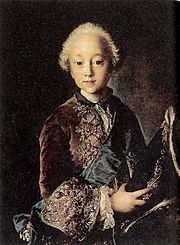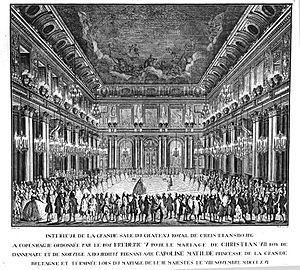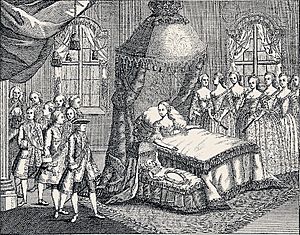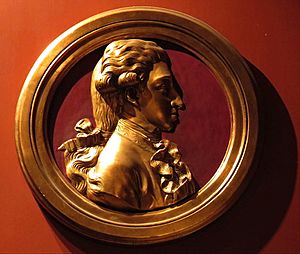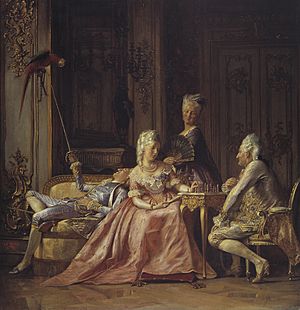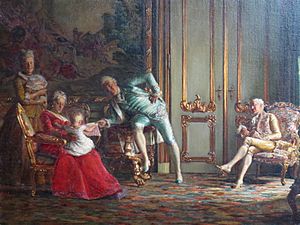Christian VII of Denmark facts for kids
Quick facts for kids Christian VII |
|
|---|---|

Portrait by Alexander Roslin, c. 1772
|
|
| King of Denmark and Norway (more...) | |
| Reign | 14 January 1766 – 13 March 1808 |
| Coronation | 1 May 1767 Christiansborg Palace Chapel |
| Predecessor | Frederick V |
| Successor | Frederick VI |
| Regents |
See list
|
| Chief Ministers |
See list
Count Johann Hartwig Ernst von Bernstorff
Johann Friedrich Struensee Ove Høegh-Guldberg Andreas Peter Bernstorff Christian Günther von Bernstorff |
| Born | 29 January 1749 Christiansborg Palace, Copenhagen, Denmark |
| Died | 13 March 1808 (aged 59) Rendsburg, Duchy of Holstein |
| Burial | Roskilde Cathedral |
| Spouse | |
| Issue | Frederick VI of Denmark Louise Auguste, Duchess of Schleswig-Holstein-Sonderburg-Augustenburg |
| House | Oldenburg |
| Father | Frederick V |
| Mother | Louise of Great Britain |
| Religion | Lutheran |
Christian VII (born 29 January 1749 – died 13 March 1808) was a king from the House of Oldenburg. He ruled as King of Denmark–Norway and Duke of Schleswig and Holstein. His rule lasted from 1766 until his death in 1808. His motto was: "Gloria ex amore patriae", which means "Glory through love of the fatherland".
Christian VII's time as king was greatly affected by his health challenges. For most of his reign, Christian was only king in name. The people who advised him changed often. This was because different groups at court tried to gain power. From 1770 to 1772, his doctor, Johann Friedrich Struensee, became the real ruler of the country. Struensee brought in many new and modern laws. In 1772, Struensee was removed from power. After that, Christian's stepmother, Juliane Marie of Brunswick-Wolfenbüttel, his half-brother Frederick, and the politician Ove Høegh-Guldberg ruled the country. From 1784 until Christian VII died in 1808, his son, who later became Frederick VI, acted as the unofficial regent.
Contents
Early Life of Christian VII
Birth and Family History
Christian was the son of King Frederick V and his first wife, Louise of Great Britain. He was born in the Queen's Bedchamber at Christiansborg Palace. This was the royal home in Copenhagen. He was baptized just a few hours later on the same day. His godparents included his father, his grandmother, and his aunts.
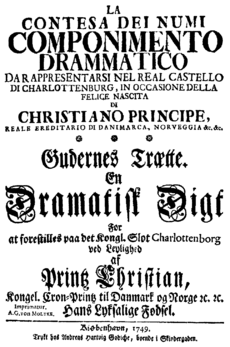
Another prince named Christian had died as a baby in 1747. So, the new baby Christian became the crown prince right after he was born. Everyone had high hopes for him. A famous musician, Christoph Willibald Gluck, wrote an opera for the occasion. It was called La Contesa dei Numi ("The Contention of the Gods"). In the opera, the gods gather to decide who should protect the new prince.
Christian had two older sisters, Sophia Magdalena and Wilhelmina Caroline. A younger sister, Louise, was born in 1750. In 1751, Christian's mother, Queen Louise, died. She was only 27 years old. The next year, his father married Duchess Juliana Maria of Brunswick-Wolfenbüttel. She gave birth to Christian's half-brother, Prince Frederick, in 1753.
Childhood and Education
After his mother died early, Christian did not get much love from his parents. His stepmother, Queen Juliane Marie, showed more interest in her own son, Prince Frederick. His father also became less involved with Christian. Christian was a shy and sensitive child. He also had health challenges.
Early historians said that Christian was smart and had a good personality. However, he was not taught well. His tutor, Christian Ditlev Frederik Reventlow, was very strict. Christian seemed to be intelligent and had times when he was very clear-headed. But he also had serious emotional problems.
Christian VII's Early Reign
Becoming King
After a long illness, Frederick V died on 14 January 1766. He was only 42 years old. When his father died, Christian immediately became the King of Denmark and Norway. He was the sixth absolute monarch of these countries. This happened a few weeks before his 17th birthday. Later that day, Christian was announced as king from the balcony of Christiansborg Palace. Christian's rule was affected by his health. For most of his time as king, he was only king in name. His royal advisors changed often.
His Marriage
Later that same year, the young king married his cousin, Caroline Matilda of Great Britain. She was only 15 years old. This marriage was arranged to connect the royal families. They had been engaged since 1765. Her brother, King George III of Great Britain, was worried about Christian's health.
They had a first wedding ceremony on 1 October 1766 in London. The Princess's brother stood in for the groom. After she arrived in Copenhagen, another wedding took place on 8 November 1766. This was in the royal chapel at Christiansborg Palace. Wedding parties and balls lasted for another month. On 1 May 1767, Christian VII and Caroline Matilda were crowned King and Queen. This happened in the royal chapel of Christiansborg Palace.
Their marriage was not a happy one. The king's health challenges grew worse. He showed little interest in the queen. On 28 January 1768, Queen Caroline Mathilde gave birth to their son. This was the future King Frederick VI. He was born at Christiansborg Palace.
Struensee's Influence

Johann Friedrich Struensee was Christian's personal doctor. He was a very modern and forward-thinking person. In the late 1760s, he slowly gained more and more power. He became the real ruler of the country. Struensee was supported by a group of smart people who wanted new ideas. He was a good doctor. He helped the king's health a bit. Because of this, the king grew fond of him.
Struensee became the king's traveling doctor on 5 April 1768. He went with the king on a trip to Paris and London. He was given the title of State Councilor on 12 May 1768. The queen, Caroline Matilda, felt lonely and ignored. She became close with Struensee.
From 1770 to 1772, Struensee was the actual leader of the country. He brought in many new and modern laws. King Christian VII signed these laws. In 1772, Struensee was removed from power by a sudden change in government. After this, Christian's stepmother, Juliane Marie of Brunswick-Wolfenbüttel, his half-brother Frederick, and the politician Ove Høegh-Guldberg ruled the country.
The Royal Divorce
The king divorced Caroline Matilda in 1772. They had two children: the future King Frederick VI and Princess Louise Auguste. Struensee, who had made many modern changes, was arrested and executed that same year. Christian signed the order for Struensee's arrest and execution. He did this because his stepmother, Queen Juliana Maria, put pressure on him. She had led the effort to end the marriage.
Caroline Matilda kept her title as queen but lost her children. She left Denmark and lived the rest of her life in exile. She stayed at Celle Castle in her brother's German land. She died there from an illness on 10 May 1775. She was only 23 years old.
Later Life of Christian VII
Christian was only king in name from 1772 onwards. Between 1772 and 1784, Denmark-Norway was ruled by his stepmother, Queen Dowager Juliane Marie. It was also ruled by his half-brother Frederick and the Danish politician Ove Høegh-Guldberg. From 1784, his son Frederick VI ruled as a prince regent.
This time of regency brought many changes. There were new laws, and improvements in farming. However, there were also difficult times. These included wars and the start of the Napoleonic Wars. At the same time, a movement for Norway to become separate was growing.
Death and Who Ruled Next

Christian died at age 59 from a stroke. This happened on 13 March 1808 in Rendsburg, Schleswig. Some stories said he was scared by Spanish soldiers, thinking they were enemies. However, a book about the king does not say there was any outside reason for his death. He was buried in Roskilde Cathedral. His son, Frederick VI, became the next king.
Christian VII's Legacy
Helping Science
In 1769, Christian VII of Denmark invited a Hungarian astronomer named Miksa Hell to Vardø. Hell watched the transit of Venus. His calculations helped find the distance between the Earth and the Sun. It was the most accurate measurement up to that time. It was about 151 million kilometers. Hell's friend János Sajnovics also studied how the languages of the Sami, Finnish, and Hungarian people were similar. These languages are all part of the Finno-Ugric language family.
Christian VII in Art and Stories
The story of Christian VII, his marriage, and his wife's relationship with Struensee has been shown in many artistic works.
Books
- 1935 : The Prisoner of Celle – a 1935 novel by Else von Hollander-Lossow.
- 1935 : The Favourite of the Queen – a 1935 novel by Robert Neumann.
- 1948 : The Queen's Physician – a 1948 novel by Edgar Maass.
- 1953 : Converse at Night in Copenhagen – a 1953 novel by Karen Blixen.
- 1955 : Caroline Matilda, princess of Great Britain and queen of Denmark – a 1955 novel by Geoffrey Vaughan Blackstone.
- 1969 : The Lost Queen – a 1969 novel by Norah Lofts.
- 1985 : Letter from Celle – a 1985 dramatic poem by Edward Lowbury.
- 1999 : The Visit of the Royal Physician – a 1999 novel by Per Olov Enquist.
- 2000 : Princess of Blood – a novel about Caroline Mathilde – a 2000 novel by Bodil Steensen-Leth.
- 2015 : There's a mad king in Denmark – a 2015 biographical novel by Dario Fo.
Stage Plays and Ballets
- 1827 : Struensee – an 1827 play by Michael Beer. His brother Giacomo Meyerbeer wrote the music.
- 1991 : Caroline Mathilde – a 1991 ballet by the Royal Danish Ballet. Flemming Flindt created the dances.
- 2008 : The Visit of the Royal Physician – a 2008 opera by the Royal Danish Opera. Bo Holten composed the music.
Films
- 1923 : The Love of a Queen – a 1923 German historical drama silent film. Christian VII was played by Walter Janssen.
- 1935 : The Dictator – a 1935 British film. Christian VII was played by Emlyn Williams.
- 1957 : King in Shadow – a 1957 West German feature film. Christian VII was played by Horst Buchholz.
- Caroline - den sidste rejse - a 2010 Danish film.
- 2012 : A Royal Affair – a 2012 Danish historical drama film. King Christian was played by Mikkel Boe Følsgaard.
Images for kids
See also
 In Spanish: Cristián VII de Dinamarca para niños
In Spanish: Cristián VII de Dinamarca para niños



